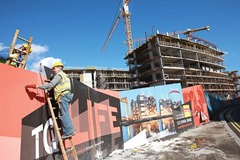Construction trends
 agendaNi considers the latest construction output and employment figures.
agendaNi considers the latest construction output and employment figures.
The construction sector in Northern Ireland has been the most severely impacted in the UK since the economic downturn, both in terms of output and jobs. Between January and March of this year, construction output had decreased by 8.6 per cent since the same period in 2013 and was approximately 46 per cent lower than before the economic downturn.
Construction output in Great Britain has been consistently higher than in Northern Ireland over the past four years. The current output for Northern Ireland comprises only three-quarters of the average construction levels recorded in 2010, significantly lower than Great Britain’s current output which stands at around 97 per cent of 2010 levels.
In the first quarter of 2014, new construction activity accounted for 68 per cent of all output, whilst repair and maintenance accounted for the remaining 32 per cent. New construction work was down 10.1 per cent on the previous year. In contrast to the sharp decline of overall output and new construction projects, repair and maintenance has remained fairly consistent over the past four years in both Great Britain and Northern Ireland.
Other work, which makes up 43 per cent of all construction output, includes all industrial and non-industrial construction work carried out by both the private and public sector. It has increased by 6.4 per cent on the previous year and is at its highest level for the past two years. New private commercial work has experienced the largest decline. New public sector construction has also generally decreased since 2009 although there was a small increase at the end of 2013.
Infrastructure made up 23 per cent of total construction output between January and March this year. The volume of infrastructure projects under way declined by 22.9 per cent on the same period in 2013 and was at its lowest since 2010. Contrary to the downturn in construction sub-sectors generally, infrastructure construction levels have been broadly consistent with the 2010 average and have experienced variable growth.
Housing output in the first quarter of this year was down 13.2 per cent on the same period in 2013 and made up 34 per cent of total output. This is was due to a sharp decrease in new private housing over the downturn, which stood at only a quarter of the levels it had previously reached during the housing boom.
Employment in the construction sector has significantly decreased from peak levels. In March 2014, approximately 30,010 people were employed in construction in Northern Ireland. This has fallen from 46,820 jobs in 2007, a 36 per cent decrease. At the end of 2013, around 23,000 people were self-employed in the construction industry, a decrease of 10,000 from 2008. Construction has been the worst affected sector in terms of job losses.
Employment Minister Stephen Farry’s new apprenticeship strategy ‘Securing our Success’ aims to increase employment and create jobs in the construction industry. He commented: “Traditionally, apprentices in occupational areas such as construction have gone on to become self-employed or to establish their own business. Apprentices have become employers and, in turn, employ apprentices.”





